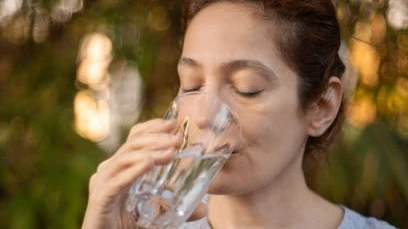Water is essential for every cell and system in your body, from temperature regulation and digestion to joint lubrication and brain function.
But there’s no single “one-size-fits-all” number. Here’s a clear, practical guide to how much you should drink, factors that change your needs, and easy ways to stay properly hydrated.
SIMPLE RULES OF THUMB
- The 88 rule: Drink eight 8-ounce glasses of water a day (~2 litres). Easy to remember, reasonable for many people.
- Know the guideline ranges: Many health bodies recommend roughly 2.7 L/day for women and 3.7 L/day for men of total water from all beverages and food, not just plain water.
- Listen to your body: Thirst and urine colour are simple, practical indicators (pale straw-coloured urine usually means good hydration).
WHAT ‘TOTAL WATER’ MEANS
‘Total water’ includes
- Plain drinking water and other beverages (tea, coffee, milk, juice)
- Water contained in foods (fruits, vegetables, soups) typically 20-30% of intake for most diets
- So you don’t need to drink every millilitre as plain water-many common drinks and foods contribute.
FACTORS THAT INCREASE YOUR NEEDS
- Physical activity: More sweating = more replacement needed. Add 350-700 ml (about 1-2 cups) per 30-60 minutes of moderate exercise – more in intense heat.
- Hot or humid weather: You’ll sweat more; increase fluids.
- High altitude: Can increase fluid losses and thirst.
- Illness or fever: Vomiting, diarrhoea, fever, increase losses – replace fluids and electrolytes.
- Pregnancy and breastfeeding: Needs go up; breastfeeding mothers especially need extra fluids.
- High-salt, high-protein, high-fibre diets: May modestly increase water needs.
SIGNS YOU’RE DEHYDRATED (DRINK MORE)
- Dark yellow urine or greatly reduced urine output
- Dry mouth, dry skin, or cracked lips
- Headache, lightheadedness, or fatigue
- Reduced concentration, dizziness, rapid heartbeat
- In infants/children: fewer wet nappies, lethargy, sunken eyes/fontanelle
SIGNS OF DRINKING TOO MUCH (OVERHYDRATION)
- Clear, excessive urine combined with bloating or nausea
- Hyponatremia (rare, from drinking extreme amounts quickly) – symptoms include headache, confusion, seizures
- Don’t force excessive amounts unless advised by a clinician (endurance athletes and certain medical conditions require tailored plans)
SPECIAL POPULATIONS QUICK NOTES
- Children: Hydration needs vary by age and activity; offer small, frequent drinks. Avoid forcing large volumes.
- Elderly: Thirst sensation decreases with age – schedule drinks and watch urine colour.
- People with heart/kidney disease: Follow clinician guidance – fluid restrictions may apply.
- Athletes: Use sweat-rate based plans, include electrolyte replacement for long/exerting sessions.
PRACTICAL HYDRATION STRATEGIES
- Carry a reusable bottle and sip throughout the day.
- Start the day with a glass of water.
- Drink before, during, and after exercise.
- Include hydrating foods: cucumbers, watermelon, oranges, soups, and yoghurt.
- Use a phone reminder or habit trigger (e.g., after each bathroom break).
If you drink lots of caffeinated beverages, they still contribute to hydration but balance with water.
MYTHS AND MISCONCEPTIONS
Myth: You must drink exactly 2 litres a day.
Reality: Needs vary – age, sex, weight, activity, climate, and diet matter.
Myth: Coffee and tea dehydrate you.
Reality: Regular caffeine drinks count toward total fluid intake; the mild diuretic effect is not significant for habitual consumers.
Myth: Clear urine always means perfect hydration.
Reality: Very clear urine can indicate overhydration; aim for pale straw colour.
A PRACTICAL DAILY PLAN (EXAMPLE)
- Morning: 1 glass (200-300 ml) after waking.
- Mid-morning: Sip from bottle (300-400 ml).
- Lunch: Drink with meal (200-300 ml) + hydrating foods.
- Afternoon: Sip regularly (300-400 ml).
- Pre/during/post exercise: 200-500 ml depending on duration.
- Evening: 1 glass with dinner; avoid massive volumes right before bed.
Adjust quantities to meet your total target based on the factors above.
WHEN TO SEEK MEDICAL ADVICE
- Persistent signs of dehydration despite drinking more
- Dizziness, confusion, fainting, or very low urine output
- If you have heart, kidney, or liver disease and are unsure about fluid limits
There’s no single magic number, but aiming for roughly 2-3.7 litres of total water a day (including food and drinks), paying attention to thirst and urine colour, and increasing intake during exercise or hot weather will keep most people well-hydrated.
Personalise based on activity, health status, and environment, and check with a clinician for medical conditions.
